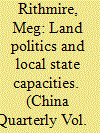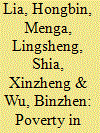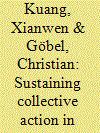|
|
|
Sort Order |
|
|
|
Items / Page
|
|
|
|
|
|
|
| Srl | Item |
| 1 |
ID:
124891


|
|
|
|
|
| Publication |
2013.
|
| Summary/Abstract |
Despite common national institutions and incentives to remake urban landscapes to anchor growth, generate land-lease revenues and display a capacious administration, Chinese urban governments exhibit varying levels of control over land. This article uses a paired comparison of Dalian and Harbin in China's north-east to link differences in local political economies to land politics. Dalian, benefiting from early access to foreign capital, consolidated its control over urban territory through the designation of a development zone, which realigned local economic interests and introduced dual pressures for enterprises to restructure and relocate. Harbin, facing capital shortages, distributed urban territory to assuage the losers of reform and promote economic growth. The findings suggest that 1) growth strategies, and the territorial politics they produce, are products of the post-Mao urban hierarchy rather than of socialist legacies, and 2), perhaps surprisingly, local governments exercise the greatest control over urban land in cities that adopted market reforms earliest.
|
|
|
|
|
|
|
|
|
|
|
|
|
|
|
|
| 2 |
ID:
124895


|
|
|
|
|
| Publication |
2013.
|
| Summary/Abstract |
We use the Chinese College Student Survey, conducted in 2010, to examine levels of poverty among students on China's campuses. With the poverty line defined as the college-specific expenditures a student needs to maintain a basic living standard on campus, we find that 22 per cent of college students in China are living in poverty. Poverty is more severe among students from rural or western parts of the country. With a targeting count error of more than 50 per cent, it is important that the college need-based aid programme be improved. Lacking other income sources, poor students rely heavily on loans and paid employment to finance their college education.
|
|
|
|
|
|
|
|
|
|
|
|
|
|
|
|
| 3 |
ID:
124890


|
|
|
|
|
| Publication |
2013.
|
| Summary/Abstract |
In recent years there has been a proliferation of scholarship on protests and other forms of collective action in China. Important insights have been gained into how conflicts between social groups and local governments begin, which strategies and instruments protesters apply, and under which circumstances protests are likely to succeed or fail. However, comparatively little is known about the mobilizing structures and how such collective action can be sustained over a long period of time, in some instances over several years. Such perseverance would be remarkable even in a democracy, but it is more so in an authoritarian system where the risks of participating in collective action are higher and the chances to succeed much smaller. This article compares the development of public protests in two research locations and identifies four factors instrumental to overcoming the formidable challenges of sustaining collective action in China: the continuing existence of substantial grievances; the re-activation of strong social ties; the presence of unifying frames; and an adaptive protest leadership. The comparison shows that the last factor is particularly crucial: while the two villages were similar in all other respects, leadership in village B was far more adaptive than in village A, which goes a long way towards explaining why collective action could be sustained twice as long in village B.
|
|
|
|
|
|
|
|
|
|
|
|
|
|
|
|
|
|
|
|
|